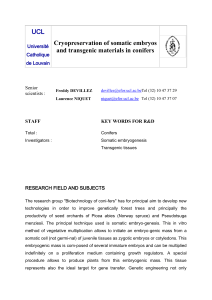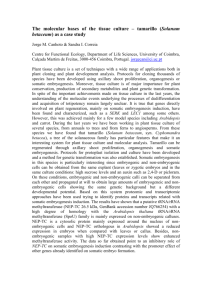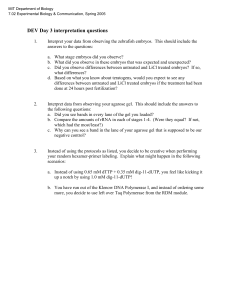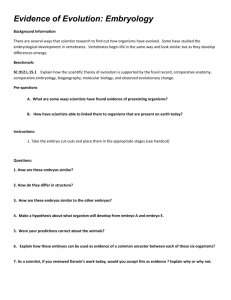Induction of direct somatic embryogenesis and plant regeneration from Arachis hypogaea
advertisement
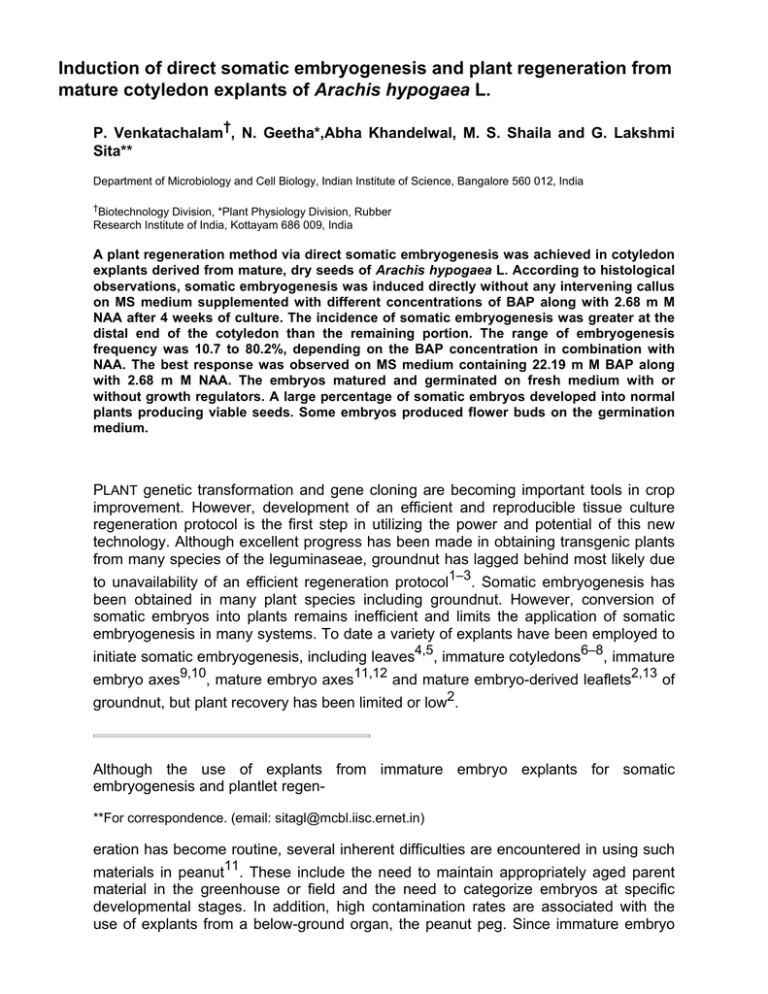
Induction of direct somatic embryogenesis and plant regeneration from mature cotyledon explants of Arachis hypogaea L. P. Venkatachalam†, N. Geetha*,Abha Khandelwal, M. S. Shaila and G. Lakshmi Sita** Department of Microbiology and Cell Biology, Indian Institute of Science, Bangalore 560 012, India † Biotechnology Division, *Plant Physiology Division, Rubber Research Institute of India, Kottayam 686 009, India A plant regeneration method via direct somatic embryogenesis was achieved in cotyledon explants derived from mature, dry seeds of Arachis hypogaea L. According to histological observations, somatic embryogenesis was induced directly without any intervening callus on MS medium supplemented with different concentrations of BAP along with 2.68 m M NAA after 4 weeks of culture. The incidence of somatic embryogenesis was greater at the distal end of the cotyledon than the remaining portion. The range of embryogenesis frequency was 10.7 to 80.2%, depending on the BAP concentration in combination with NAA. The best response was observed on MS medium containing 22.19 m M BAP along with 2.68 m M NAA. The embryos matured and germinated on fresh medium with or without growth regulators. A large percentage of somatic embryos developed into normal plants producing viable seeds. Some embryos produced flower buds on the germination medium. PLANT genetic transformation and gene cloning are becoming important tools in crop improvement. However, development of an efficient and reproducible tissue culture regeneration protocol is the first step in utilizing the power and potential of this new technology. Although excellent progress has been made in obtaining transgenic plants from many species of the leguminaseae, groundnut has lagged behind most likely due to unavailability of an efficient regeneration protocol1–3. Somatic embryogenesis has been obtained in many plant species including groundnut. However, conversion of somatic embryos into plants remains inefficient and limits the application of somatic embryogenesis in many systems. To date a variety of explants have been employed to initiate somatic embryogenesis, including leaves4,5, immature cotyledons6–8, immature embryo axes9,10, mature embryo axes11,12 and mature embryo-derived leaflets2,13 of groundnut, but plant recovery has been limited or low2. Although the use of explants from immature embryo explants for somatic embryogenesis and plantlet regen**For correspondence. (email: sitagl@mcbl.iisc.ernet.in) eration has become routine, several inherent difficulties are encountered in using such materials in peanut11. These include the need to maintain appropriately aged parent material in the greenhouse or field and the need to categorize embryos at specific developmental stages. In addition, high contamination rates are associated with the use of explants from a below-ground organ, the peanut peg. Since immature embryo explants are not always readily available, attempts have been made to regenerate plants from other explants including hypocotyls14. The general application of somatic embryogenesis requires the development of uniform, high efficiency regeneration systems which can produce plants that perform as seed-derived plants. The development of protocols to establish embryogenic cultures using more readily available material would alleviate many of the problems associated with immature embryo explants. In this report, we describe a simple and efficient protocol that uses cotyledons from mature, dry, stored seeds from which somatic embryos can be induced at a high frequency. Mature seeds of Arachis hypogaea L. cv. TMV-2 were obtained from Tamil Nadu Agricultural University, Coimbatore, India. The seeds were surface sterilized with 0.1% (W/V) aqueous mercuric chloride solution for 7 min and thoroughly washed with sterile distilled water several times. Then, the seeds were divided into two halves and embryogenic axes were removed from the cotyledons. Deembryonated cotyledons (without any pre-existing meristem) were placed on MS medium15 with growth regulators for induction of somatic embryogenesis. The medium consisted of MS basal salts and vitamins supplemented with NAA (2.68 m M), BAP (2.21, 4.43, 8.87, 22.19 and 44.39 m M) and sucrose (30 g/l) for somatic embryo initiation and proliferation. The pH of the medium was adjusted to 5.8 using 0.1 N HCl or 0.1 N NaOH and the medium was sterilized by autoclaving at 121° C with 1.06 kg cm–2 pressure for 15 min. Routinely, 15 ml of liquid medium with 0.8% (W/V) agar was dispensed into culture tubes (25 ´ 150 mm) and plugged with non-absorbent cotton wrapped in one layer of cheese-cloth. The cultures were incubated in a growth room at 25 ± 2° C under a 16 h photoperiod at a light intensity of 60 m Em–2s–1. When somatic embryos were observed using a stereo-microscope, embryogenic masses with proliferating embryos were transferred on to fresh embryo maturation medium which consisted of MS salts and vitamins with BAP (2.21 m M). For germination, somatic embryos were transferred from embryo maturation medium onto embryo germination medium, which consisted of half-strength MS medium without any growth regulators. In order to achieve further shoot elongation and full root development from germinated somatic embryos, plantlets were transferred to MS medium containing BAP (0.44 m M) and incubated at 25 ± 2° C under 16 h photoperiod at a light intensity of 40 m Em–2s–1 (cool-white fluorescent tubes). Well-developed plantlets were transferred to half-strength MS basal medium devoid of growth regulators and cultured for one week. Rooted plantlets from which the agar-based medium had been removed under running water, were individually transferred to 10 cm plastic pots containing soil and manure in a 1:1 ratio. In order to prevent fungal infection, plants were watered with 0.5 g/l Bavistin solution, after which each pot was covered with a polythene bag. Pots were maintained under controlled environmental conditions (25 ± 2° C under 16 h photoperiod at a light intensity of 40 m Em–2s–1) and the polythene bags were progressively opened over a 2-week period. Subsequently, well-established plants were shifted to field. A minimum of 25–30 explants were cultured for each treatment combination and each experiment was repeated thrice. The data pertaining to percentage of embryogenesis and mean number of embryos per culture were calculated and statistically analysed by the Duncan’s New Multiple Range Test. Among the treatments, the average figures followed by similar letter are not significantly different at the 1% level. For histological studies, the embryos at various stages of embryogenesis were fixed in FAA for 24 h. Tissues were dehydrated by transferring embryos through an ethanol–xylol series and then were infiltrated and embedded in paraffin. Tissues were sectioned to 6 m m with a microtome, mounted on glass slides, and stained with safranin. Photographs were taken under Nikon light microscope. Direct somatic embryogenesis was observed from mature cotyledon explants within 30 days of culture initiation. Cotyledons enlarged after 7 days of culture initiation on induction medium. Greenish rounded structures appeared on the cut end of the explants within 2 weeks of culture on MS medium augmented with varying concentrations of BAP in combination with NAA (2.68 m M). These protuberances are referred to as embryos (Figure 1 a, b). The frequency of embryogenesis increased with the concentration of BAP from 2.21 µM up to 22.19 m M, then decreased with further increase in the concentration. Among the various concentrations tested, BAP at 22.19 m M was the optimum concentration for high frequency of embryogenesis as well as the maximum number of somatic embryos (Table 1). Cotyledon explants (control) cultured on basal medium in the absence of any exogenous growth regulators never differentiated to produce somatic embryos, but occasionally formed roots. Maximum embryogenesis obtained was 80.2% with 2.68 m M NAA and 22.19 m M BAP combination which was statistically significant at 1% level. Using cotyle- Figure 1 a–c. Plantlet regeneration by somatic embryogenesis from groundnut mature cotyledon explants. a, Mature cotyledon explant exhibiting somatic embryogenesis on induction medium (bar = 40 mm); b, A general surface view of embryo masses (bar = 100 mm); c, Group of somatic embryos at various developmental stages (bar = 100 mm). dons of dried seed, an unlimited number of easily discernible embryos were available (Figure 1 c). Somatic embryos were produced from the embryo axes of mature, dry seeds of peanut7,11. Otherwise, all previous studies have used immature axes or axes from freshly harvested seed as explants8–10,12. Our results showed that mature seed cotyledons were highly responsive in culture for somatic embryogenesis. If the embryos were not subcultured at the earliest stage they usually developed Figure 1 d–i. Plantlet regeneration by somatic embryogenesis from groundnut mature cotyledon explants. d–f, Different stages of embryos (heart, torpedo and cotyledonary bar = 100 mm); g, A mature embryo with well-formed radicle, long hypocotyl and two short cotyledons (bar = 100 mm); h, Germination of somatic embryo with defined cotyledons and root (bar = 120 mm); i, Somatic embryo-derived plantlet established in soil (bar = 40 mm). into shoots only. This has been reported in other tree legumes – rosewood16. George and Eapen7 reported that mature cotyledons did not produce somatic embryos. This is in contrast to the present results. Somatic embryos which developed within 4 weeks from 80% of the embryogenic masses were transferred to maturation medium. Embryos of various shapes and stages (Figure 1 d–g) were visible in the clusters, indicating that the process of embryogenesis was asynchronous. Cotyledonary embryos were also noticed after 4 weeks of culture on the same maturation medium. Most such embryos were morphologically normal, and green in appearance with a distinct hypocotyl region and normal cotyledons (Figure 1 f ). Many embryos underwent further development by elongation of the hypocotyl and cotyledon expansion producing later stage embryos (Figure 1 g). These embryos frequently exhibited secondary embryogenesis, unless transferred to embryo germination medium, with early stage embryos being produced from the hypocotyl and cotyledons. During somatic embryogenesis from immature leaflets of peanut, globular, heart and torpedo stages were not clearly delimited13. The present findings on NAA/BAP-stimulated embryo induction are in contrast to all previous results in peanut2,5,6,9,12,13 and also differ from previous experience with legumes in general, in which somatic embryos were obtained with 2,4-D and NAA alone or in combination. The auxin 2,4-D was found to be effective in inducing somatic embryos in peanut2,5,6,13, while NAA in the induction medium was also effective. Cytokinin-stimulated direct somatic embryo induction from non-embryogenic tissue has also been well documented in other legumes like Phaseolus17 and winged bean18,19. Thus, it is difficult to formulate a generalized protocol for somatic embryogenesis in grain legumes, as the growth regulator requirements appear to be species- and tissue-specific. Germination of somatic embryos was observed on half-strength MS basal medium without growth regulators after 2 weeks of culture. Though the somatic embryos showed both root and shoot meristems, simultaneous development of root and shoot was only infrequently observed. More often, shoots emerged from the embryos, which subsequently produced roots on the same medium when cultured for 4–6 weeks (Figure 1 h). Further root and shoot development was achieved when somatic embryo-derived plantlets were transferred to MS basal medium containing low concentration of BAP (0.44 m M). Adventitious roots developed in some cultures. Similar results were also reported in winged bean19 and peanut2,13. The plantlets were subsequently transferred to pots containing soil mixture (soil:manure in the 1:1 ratio) and maintained in the controlled environment for a week (Figure 1 i). Subsequently, they were shifted to field conditions and 90–95% of them survived, grew normally and set viable seeds. In the pre- Figure 2 a–d. Histology of somatic embryogenesis of groundnut. a, Longitudinal section of globular embryo development on the surface of the explant (bar = 50 m m); b, Longitudinal section of early heart-shaped embryo (bar = 50 m m); c, Longitudinal section of late heart-shaped embryo (bar = 50 m m); d, Longitudinal section of somatic embryo (cotyledonary stage) showing two distinct cotyledons with root meristem (bar = 50 µm). sent study, some somatic embryos produced flower buds in culture. The flowering behaviour of groundnut cultures suggests that some of the less developed meristematic buds, possibly were influenced by higher concentration of cytokinin in the medium. This resulted in modulating the buds to change from vegetative to reproductive phase. This observation is in concurrence with that of earlier researchers20, suggesting that cytokinin triggers flowering. More than 58 plantlets were produced out of 100 embryos cultured on germination medium. The average plant conversion was 55% (data not shown). Interestingly, in our findings cotyledonary embryos appeared to be normal and were similar to class-2 embryos described in peanut by Wetzstein and Baker21. Most of the literature on the conversion of peanut somatic embryos and survival of somatic embryo-raised plantlets in soil described low frequencies of conversion5–13. Histology of somatic embryo-producing regions of cotyledons confirmed that the induction of the development process was embryogenic and not organogenic in nature. Light microscopic observations of embryogenic mass revealed the presence of nodular structures containing cytoplasmic cells at the central region. Development of somatic embryos appeared to progress through typical globular-, heart-, torpedo-shaped and cotyledonary stage embryo development. The first sign of embryogenesis was marked by the appearance of globular structures that were attached to the surface of the explant by a distinct stalk (Figure 2 a). The heart-stage embryo (Figure 2 b), which was bilaterally symmetrical also showed a broad suspensor-like stalk. Some of the structures also had vascular tissue with unipolar meristems which ultimately developed into roots. The densely stained meristematic area was often completely surrounded by parenchymatous tissue. At this stage, development of clear bipolar embryos with organized shoot and root portion was observed (Figure 2 c). The cotyledonary-stage embryos showed the presence of two prominent cotyledons (Figure 2 d). In the present study, cotyledons were used to obtain a high frequency of somatic embryogenesis, and cotyledons from mature seeds are a convenient, accessible and efficient explant for somatic embryogenesis in groundnut. We have used only one medium containing BAP in combination with low concentration of NAA for embryo initiation and proliferation. To overcome the limitation or low percentage of plant conversion, half-strength MS basal medium without any growth regulators was used for embryo germination. The protocol described here could be useful in experiments on genetic transformation. 1. 2. 3. 4. 5. 6. 7. 8. 9. 10. 11. 12. 13. 14. 15. Cheng, M., His, D. C. H. and Phillips, G. C., Peanut Sci., 1992, 19, 82–87. Chengalrayan, K., Mhaske, V. B. and Hazra, S., Plant Cell Rep., 1997, 16, 783–786. Kanyand, M., Dessai, A. P. and Prakash, C. S., Plant Cell Rep., 1994, 14, 1–5. Mhaske, V. B., Chengalrayan, K. and Hazra, S., Plant Cell Rep., 1998, 17, 742–746. Baker, C. M. and Wetzstein, H. Y., Plant Cell Rep., 1992, 11, 71–75. Baker, C. M. and Wetzstein, H. Y., Plant Cell Tissue Org. Culture, 1994, 36, 361–368. George, L. and Eapen, S., Oleagineux, 1993, 48, 361–364. Ozias-Akins, P., Anderson, W. F. and Holbrook, C. C., Plant Sci., 1992, 83, 103–111. Hazra, S., Sathaye, S. S. and Mascarenhas, A. F., Bio/Technology, 1989, 7, 949–951. Ramdev Reddy, L. and Reddy, G. M., Indian J. Exp. Biol., 1993, 31, 57–60. Baker, C. M., Durham, R. E., Austin, Burns, J., Parrott, W. A. and Wetzstein, H. Y., Plant Cell Rep., 1995, 15, 38–42. McKently, A. H., In Vitro Cell. Dev. Biol., 1991, 27, 197– 200. Chengalrayan, K., Sathaye, S. S. and Hazra, S., Plant Cell Rep., 1994, 13, 578–581. Venkatachalam, P., Kavi Kishor, P. B. and Jayabalan, N., Curr. Sci., 1997, 72, 271–275. Murashige, T. and Skoog, F., Physiol. Plant., 1962, 15, 473–497. 16. 17. 18. 19. 20. 21. Rao, M. M. and Lakshmi Sita, G., Plant Cell Rep., 1996, 15, 355–359. Malik, K. A. and Saxena, P. K., Plant Cell Rep., 1992, 11, 163–168. Ahmed, R., Dutta Gupta, S. and De, D. N., Plant Cell Rep., 1996, 15, 531–535. Dutta Gupta, S., Ahmed, R. and De, D. N., Plant Cell Rep., 1997, 16, 628–631. Venkatachalam, P. and Jayabalan, N., Korean J. Plant Tissue Culture, 1996, 23, 9–13. Wetzstein, H. Y. and Baker, C. M., Plant Sci., 1993, 92, 81–89. Acknowledgements. We thank the Department of Biotechnology (DBT), Govt. of India, New Delhi for financial assistance in the form of a Post-Doctoral Fellowship to one of us. We also thank P. Sairam Reddy for help in taking histological sections.

